Table of Contents
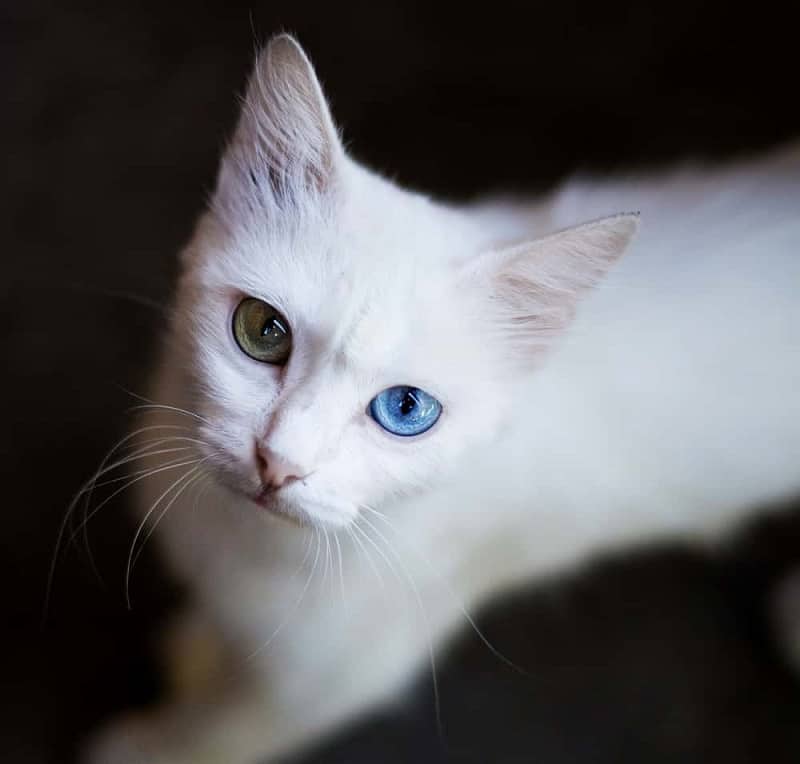
A lot of people make the mistake of thinking that albino cats and white cats are the same thing. Yes, albino cats are white, but there are thousands of white cats that are not albino. There are even websites that have made claims about albino and white cats that are completely untrue, which is just going to add to the confusion on the subject. So, today we are going to take a look at the characteristics of both white and albino cats, and you will be able to understand the differences between the two. We will also take a look at some of the myths surrounding both types of cats, and dispel most of them. Let’s get started.
What is an Albino Cat?
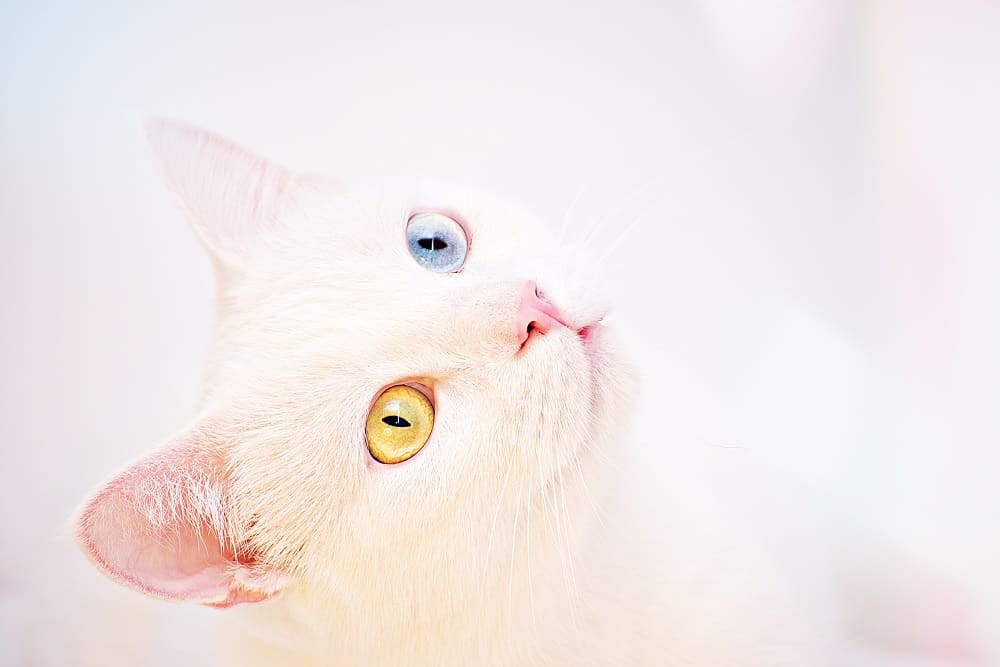
Let’s start at the start. Albinism comes from the Latin word, Albus, which basically means white. When any creature is an albino, it means that they have a genetic condition that causes them to have absolutely no pigmentation or color. For a cat to be truly albino, both parents must carry the genetic marker that makes a cat an albino. You may see a white coat, but there are a lot of subtle characteristics that make it a lot different from a regular white coat. Even the eyes and skin are going to be different with an albino cat. But, other than these differences, an albino cat is just like any other cat, and there are no major health issues.
One of the easiest ways to tell if a cat is albino or just a white cat is to look at its eyes. Average white cats can have a variety of eye colors, from green to gold to blue to one blue and one gold or green (known as heterochroma, or odd-eye). Albino cats do not have the same color spectrum. In fact, theirs is very limited, because there is no pigmentation. In most cases, an albino cat will have very pale blue eyes, or they may even be pink to pinkish-blue.
Now, this might confuse you a bit. In this case, pink is not actually a color. Instead, it is light that is reflecting the blood vessels in the eyes. This is also why an albino cat has no pigmentation in their skin, which usually appears to be one of many shades of very pale pink to light pink. Again, this is the light reflecting the blood flow beneath the skin.
In order for the body to produce melanin, the TYR or tyrosinase gene must be present. When a kitten or other animal is born without this gene, their body can’t produce melanin. A kitten that is born with a damaged or missing TYR gene is considered to be albino. Again, this can only happen if both parents carry the gene that is defective, and they will then pass it on.
Not only does melanin play a role in the color of the fur and eyes, it also helps to protect animals from the harsh rays of the sun. Melanin blocks out the harmful UV rays, while allowing the good rays to provide vitamin D. Melanin also plays an important role in the development of the eyes, particularly the optic nerves, muscles, and the irises. When there is a melanin deficiency, an animal may have difficulty with depth perception, focusing and tracking.
If you have or are considering getting an albino cat, it is best to make sure that it remains an indoor cat. Not only is it not likely to have great hunting skills due to the poor depth perception, tracking and focusing, it can also have vision issues because of the sun, as well as skin damage. Albino cats tend to be prone to skin cancer.
It is not just cats that can be albino. Most species have albinism at some points. For instance, Snow Bengals and some Oriental cat breeds are considered to be albinos. These animals are born white, and the color points develop as they get older. Other animals that can be albino include birds, fish, reptiles, amphibians, insects, mollusks, and all mammals, humans included.
Whiteness in Varying Degrees
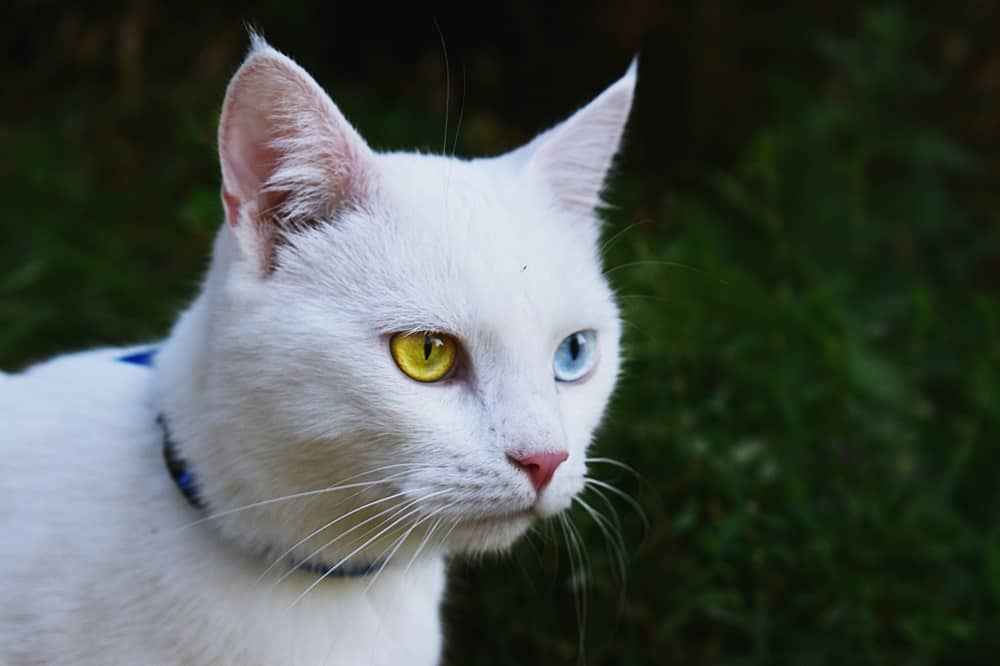
A true albino cat is a rather rare thing. Most commonly we tend to see cats that are partially albino. In fact, this is actually quite common. For instance, many of the Oriental cats, including Siamese and Burmese, get their point markings from a variation of albinism. Cats that have the color-pointed coats have colors that are more concentrated in some areas than others. This actually depends on body heat. You will see more pigmentation in the cooler areas of the body, and less on the warmer areas. So, the warm areas have lighter colorations, and the cool areas are darker n color.
Did you know that color-pointed cats are born white? This is particularly true of cats that have been developed from the Siamese lines, including Thai cats. The color patterns will develop over time as the cats age and develop.
So, what are the various degrees of albinism in cats? Let’s take a look at the dominant and recessive degrees, as well as white spotting.
First of all, you always need to remember that cats with colored eyes are not albino, and that albino cats have very pale blue to pinkish colored eyes. The reason why a white cat is white is because they have a gene that covers the other color genes. The reason why an albino cat is an albino is because they have a mutation that creates an absence of color.
So, if you hear anyone say that they have a blue or an orange eyed cat and they are calling it an albino, you can be sure that they either have no idea what they are talking about, or that they are trying to make others believe that the cat is something it is not. What they really have is a dominant white cat, and this doesn’t necessarily mean that they have dominant personalities. It is all about the color.
- Dominant White – Dominant white, also referred to as epistatic white, happens on a different gene than the black and red-based colors. Dominant white is the white that is associated with cats that are deaf, and it masks any other colors. A purebred dominant white cat can have odd, orange, or blue colored eyes, and there is a great chance that a dominant white cat with these eye colors will indeed be deaf. If the cat has one blue eye, it could be deaf on the same side as the blue eye. Deafness is less pronounced in cats with orange eyes. There are also dominant white kittens that are born with a color smudge on their heads, but this disappears as they get older. These kittens tend to not experience any deafness, and are not albinos. They can actually be any color, but white is the dominant color.
- White Spotting – The gene that causes white spotting can also make a cat seem like a self-white cat. The gene is dominant, but how it is appears can vary. For instance, a cat may be completely white, have just a little bit of white, or have various amounts of white. In the case of white spotting, there is no link to deafness. But, white spotting can be the reason why some cats are totally white, but not albino. There are grades of spotting, from zero to 10, with zero means no white spotting and 10 means almost totally white. A grade 10 white spotted cat looks like a white cat, and there is rarely any deafness. You may also notice small color spots on cats that otherwise look to be completely white, because of the white spotting gene.
- Recessive White – Now we get into the recessive white gene, which is what causes albinism. This cat has light blue or pink eyes, and the gene is recessive to both white cats and Siamese cats. Seal Point Siamese cats that have the recessive white gene are often a lot lighter in color than those that do not carry the gene. These cats also are light sensitive, and it is best to make sure that they are not exposed to bright sunlight, both for their vision and the fact that their skin can burn easily. Other than this, generally albino cats do not tend to have any health issues that any other cat might have.
Health Problems Associated with Albino Cats
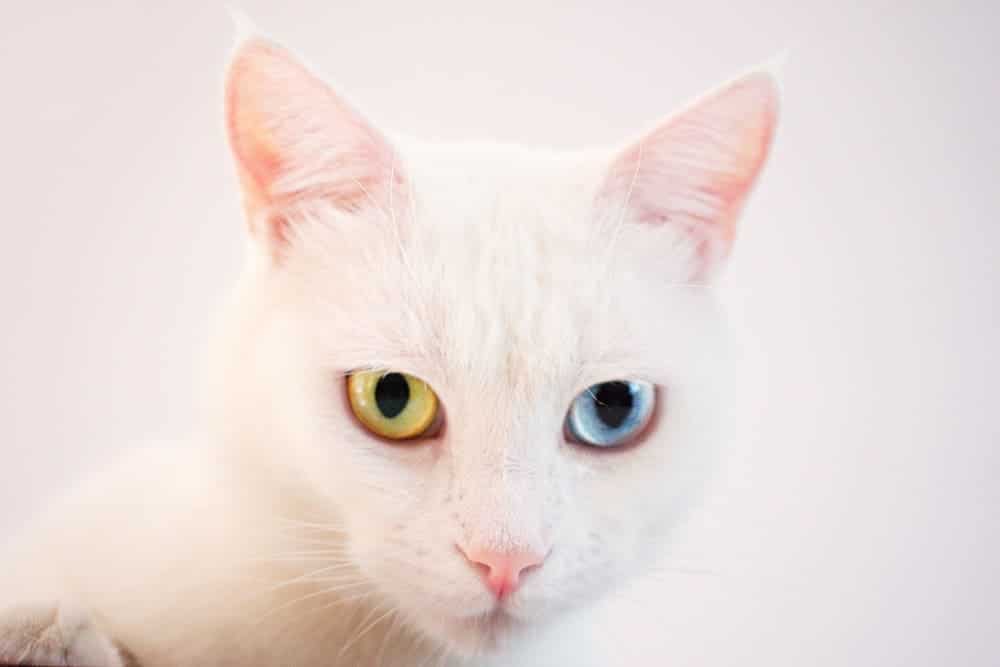
When it comes to the health of your pet, it is important to know if there are any issues that could arise as a result of the cat being an albino.
Yes, there are some health problems that are common to albino pets, which is why it is not always recommended that people get animals with albinism, even though they are highly sought after by those who are looking for purebred pets.
That’s why it is important to sought health and therapy guides about cat before planning on getting one.
Here are the most common health problems associated with albino cats.
Light Sensitivity
We touched a bit on the light sensitivity of albino cats in the last section. Let’s go a bit deeper into this subject. Because there is a lack of pigmentation in a cat that is truly an albino, it has no ability to produce melanin. While we think of melanin as something that plays a role in skin tone, it also does many other things in the body, including giving color to the hair and eyes. It can also play a role in depth perception, and it is important in helping the body fight diseases and infections.
Because melanin gives color to the eyes, the lack of melanin means that the eyes are going to be pale, and be very sensitive to light. Being in direct sunlight can be damaging to their vision. It is best that an albino cat be an indoor cat for this reason, and you should also close the blinds during those times of the day when the sun is shining directly inside.
Indirect sunlight is okay, but an albino cat should never be in direct sunlight for more than a couple of minutes at the most. This particularly important if the cat has pink or red eyes, as it can cause blindness. If you have an albino cat and you think it has vision problems, it is important to contact your vet right away so you can get the best advice on how to treat the problem, if possible.
Skin Sensitivity
We also touched on the fact that an albino cat has extremely sensitive skin. Again, it is imperative that an albino cat not be in direct sunlight for any more than a few minutes. Keep them away from direct sunlight between noon and five pm, as this is when the sun’s rays are the strongest. It is also a good idea to get a non-toxic cream from your vet to put on the cat’s nose. Albino cats can sunburn very easily, and they have a higher chance of developing skin cancer than cats that do not carry the recessive white gene.
If you have an albino cat and it goes outdoors, it is a good idea to use sunscreen. Your vet can recommend the best type. Generally, it is best to use one that is meant for babies and children, and that has no colors or scents. Even if it is an indoor cat, it is still a good idea to use a bit of sunscreen on an albino pet
Deafness
While not all white cats are deaf, as is the common misconception, cats with albinism do tend to often be partially or even completely deaf. This is due to the fact that the autosomal gene W leads to a malformation of the inner ear. This is something that is common most albino animals, including humans. In fact, it was once believed that animals and people with albinism had mental deficiencies, which is obviously not the case at all. But, because an animal that is deaf cannot hear, they can’t understand. We now know that it has nothing whatsoever to do with the animal’s intelligence.
You can usually tell if a kitten is deaf, because they do not respond when you call to them. If you have an albino cat that is deaf, you will need to come up with other methods of communication with your cat. You will also need to learn how to care for a deaf cat, because there are some differences between this and caring for a hearing pet. It is a good idea to consult with your vet to find out the best ways to communicate, train, and care for an albino cat.
Deafness in albino cats isn’t always total. For instance, if the cat is odd eyed, it may be deaf on the side that has the blue eye, while the side with the regular colored eye could have perfect hearing. There are claims that the majority of all white cats, including albino cats, are at least partially deaf, but this is not exactly accurate. This is because there are different genes that cause the different types of whiteness, and not all of these genes can lead to deafness.
It really all comes down to the genes that have been passed onto the kitten by its parents. Let’s break this down by taking a look at the following scientific figures that show the percentages of white cats, and the percentage of deafness in white cats (in either one or both ears).
- Only 5 percent of the entire cat population is white, with congenital deafness being very rare in cats that are not white.
- The 5 percent that is white is pure white, and 15 to 40 percent of all pure white cats have one or both blue eyes.
- Out of the cats with one or both blue eyes, 60 to 80 percent are deaf, with 20 to 40 percent having regular hearing. 30 to 40 percent of those with one blue eye tend to be deaf, with 60 to 70 percent having regular hearing.
- Out of the 5 percent of white cats, 60 to 80 percent have eyes that are not blue, such as orange or green. Of the cats with these color eyes, 10 to 20 percent are often deaf, and 80 to 90 percent have regular hearing.
- Deaf white cats with one or both blue eyes make up 0.25 to 1.5 percent of the total cat population.
Cats with white coats and blue eyes make up 0.75 to 2 percent of the total cat population.
Caring for an Albino Cat
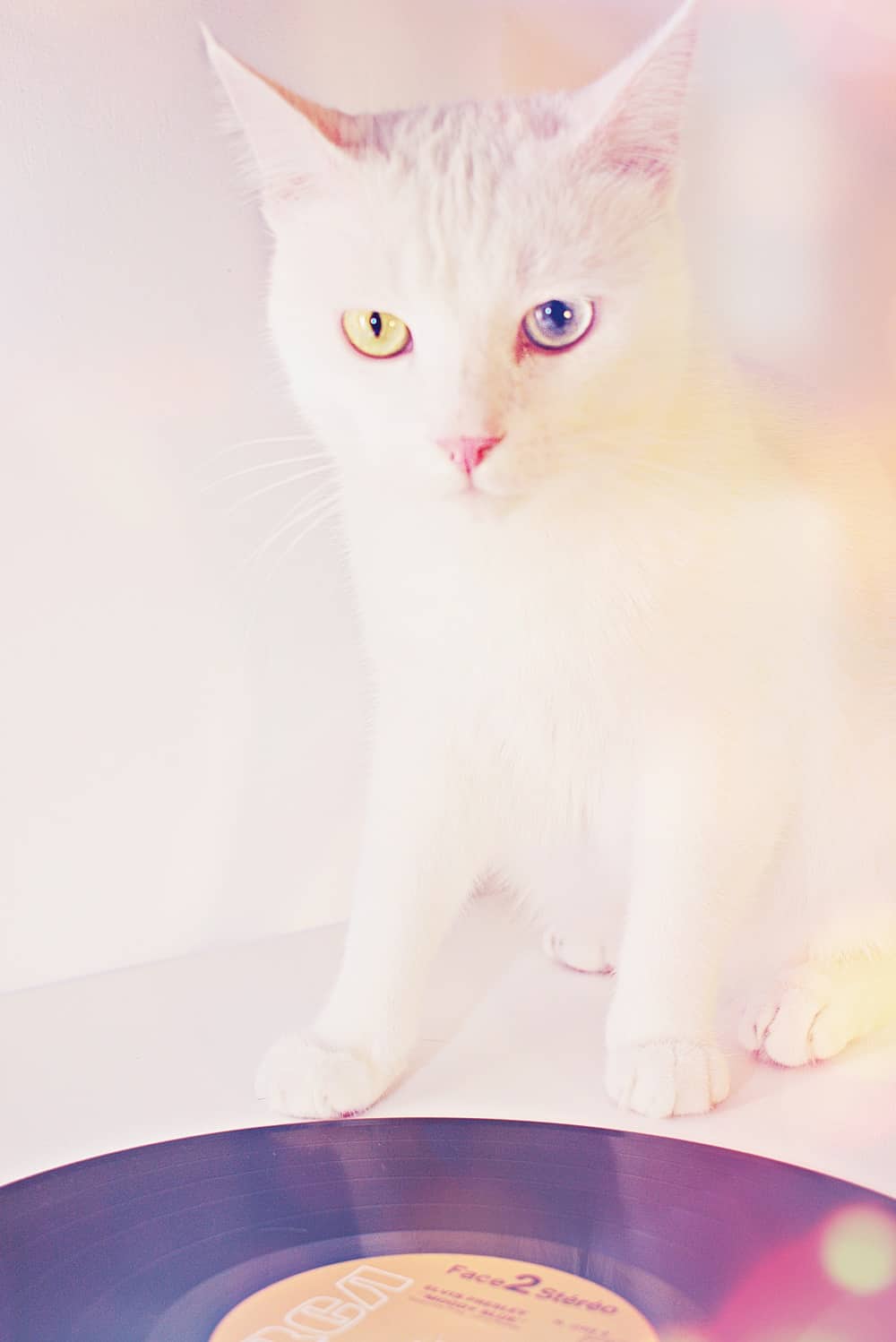
All cats require a specific amount of care, but when you have an albino cat, there are many things that you need to do differently, as they need extra-special care. In fact, this is why many people choose not to adopt an albino cat. Yes, they are beautiful to look at, but they can have many health issues that are not as common in other cats, including blindness, deafness, redness around the eyes due to sensitivity, skin problems, and even skin cancer. It is important to have a good relationship with your vet, and discuss with them the proper care for an albino cat so you can sure that yours lives a long and healthy life.
Albino Animal Myths and Facts
There are a lot of myths surrounding both white and albino cats and other animals. As we already mentioned, the only real similarity is the fact that they both have white coats. Other than that, there are actually several differences. This is just one of the myths you will hear about white and albino cats, along with many actual facts. Let’s take a look at some of the myths and facts surrounding albino cats.
- All White Cats are Deaf – We have already discussed the fact that this is just not true. Yes, a large percentage of albino cats are deaf or partially deaf, but this is due to the damaged or missing gene, and is not a problem that is common in white cats that are not albino. In fact, albino cats aren’t actually white. They lack color, which is completely different, so they are nothing like a regular white cat. Even Charles Darwin wrote, “Some instances of correlation are quite whimsical; thus cats which are entirely white and have blue eyes are generally deaf.” So, even back in the 19th century, this myth was debunked.
- Albino Animals are Worshipped – Whether it is a cat or another animal, there are some groups and cultures that revere and worship albino animals. It is often thought that animals with albinism can bring about good luck. In some cultures, albino worship is taken so seriously that it is considered a sin to hunt and kill an albino animal. It is even considered bad luck in some cultures to injure or kill an albino animal, and they hold them in great esteem.
- Albino Animals have Short Lifespans – An albino house cat is one thing. It will be properly cared for, so it should have as long of a life as any other house cat. But, an albino animal born in the wild has a very short life expectancy. Often, they are killed by their parents because they are different. If they are allowed to live, they don’t have great hunting skills, due to their lack of depth perception and the inability to focus well, and they will likely die of starvation.
Below is a short video to help you understand some facts about albino cats:
They are extremely rare with only 2% chance of occurring which possibly made some people think that Albino cats are just white cats and doesn’t exist.
Some already struggle with what cat breed do they have and much more than they’d know about the existence of Albino cats.
Conclusion
As you can see, albino cats are completely different from any other type of cat you will ever own. While it may look like a typical cat, there is nothing typical at all about an albino cat. They have different genetics, and they have health issues that are not nearly as common in other cats. Owning an albino at may be a bit of a challenge in the beginning, but as long as you make sure that it is kept out of direct sunlight, and gets the proper vet care, you should have your pet for many years to come.